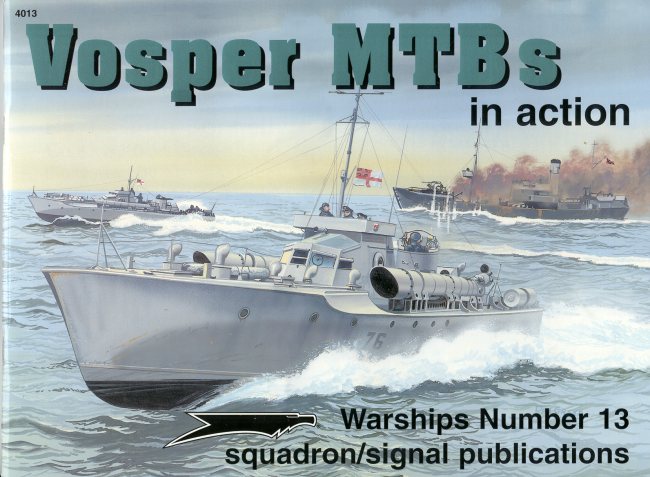
|
BOOK: |
Vosper MTBs in Action |
|
BY: |
T. Garth Connelly |
|
PUBLISHER |
Squadron Signal
Publications |
|
REVIEW BY: |
|
|
NOTES: |
Warships # 13, 2000 |

To paraphrase from the opening sentence, "The Motor Torpedo Boat (MTB)....can trace its roots back to the HMS Lightning of 1876". This boat was the forerunner of hundreds of similar boats that were used by the British in WWI and by the US and UK in WWII. Even the modern hydroplane patrol boats used by the USN are based on the concept of a light and fast attack boat.
However, as much an innovator that Thornycroft was, it was Vosper that developed what was to become the modern torpedo boat. Vosper developed a V-drive gearbox that allowed two engines to drive the same propeller shaft. This development allowed several small powerful engines to be placed into a small space. The people at Vosper knew a good thing when they saw it, and using three of the most powerful marine engines of the time, Italian Isotta-Franschini Asso 1000 engines of 1,150 hp, developed the MTB-102, as a private venture. This boat was able to reach speeds of 40 knots or more, perfect for what was planned. Accepted by the Royal Navy in 1937, this was the 'mother' of all subsequent MTBs.
The initial run of Vosper MTBs was powered by the Italian engine, however, Italy's entry into the war made the need for finding another powerplant to be of paramount importance. The British had available a Hall-Scott supercharged V8, but it only produced 950 HP and was heavier as the Isottas. Top speed was only a bit over 30 knots, not enough to be really effective. Eventually, the MTB settled on the same Packard engines as used by US PT boats. These engines offered similar performance as the US PT boats.
Unlike their American counterparts, the MTB did not go through the radical field modifications that the PT boat did. The British kept the torpedo tubes and did not develop gun boats as did Pacific PTs. The design was slightly different as well. Vosper boats did not have moveable torpedo tubes like US boats so had cut outs near the front of the boat to prevent the torpedo from hitting the boat when launched. They were also not as heavily armed and US boats. While it was not uncommon to see a 40mm cannon on a US boat, the British rarely used anything larger than 20mm.
The major exception to this was MBT 510. This was a much larger MTB and could almost be considered a corvette. It boasted a 6 pound (57mm) gun mounted forward as well as twin 20mm mounts on either side. The ship was highly developmental and did not see active combat, though it was used to test various systems including the experimental SSS (Synchro-Self-Shift) two speed gearbox. It also used 4 Packard engines and had a total of 6000 horsepower available.
Author T. Garth Connelly has done a superb job of this book. It reads very well and is quite well edited. It starts with the history of the MTB and then goes on to describe the various different designs and production runs. It is interesting to note that quite a number of them were built in the US. Several were also modified for special operations.
There are sections on construction (which I found to be especially fascinating), engines, and a large section on armament. A section on the operational usage of the MTB is also included. In addition to this section, there are operational stories spread throughout the book in the descriptions of the various production runs. The British seemed to have had more interesting experiences with their MTBs, probably due to the closeness of the enemy and the fact that the larger and more powerful German E-boats were a major concern.
The selection of photos for the book is excellent and come from a variety of sources, including private collections. The MTB was also subject to a number of interesting camouflage schemes during its operational life and these are portrayed in the center pages and on the back page with some color profiles.
All in all a really super book and a very fine companion to the early PT Boats In Action edition by the same author. The book is highly recommended to all and especially to American readers who think that only the US had these types of boat.
Review copy courtesy of the author, T. Garth Connelly and Squadron Mail Order
If you would like your product reviewed fairly and quickly by a site that has over 1,500 visits a day, please contact me or see other details in the Note to Contributors.